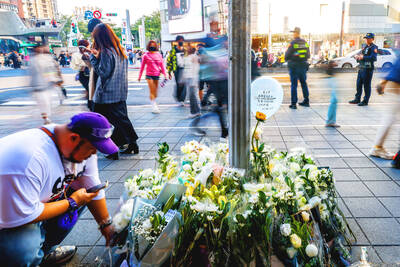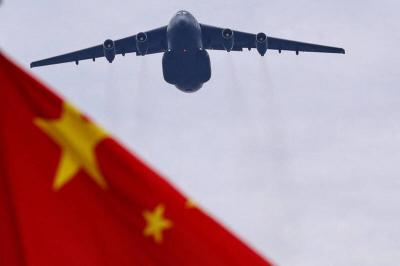A confluence of human errors were to blame for the accidental firing of a missile that sank a Taiwanese fishing boat near Penghu on July 1, the Chinese-language United Daily News reported yesterday.
The newspaper said it was given access to the working draft of the military’s report on the incident, which it characterized as “in a mostly finished form.”
Personnel on the navy’s Chinchiang-class corvette had primed and loaded the vessel’s pair of double-barrel anti-ship missile launchers for an in-port military drill that the ship was participating in, the newspaper cited the draft as saying.
During a drill, the tubes of the missile launchers are supposed to be individually loaded with live missiles and connected to simulator devices, so that the training simulator, and not the missile, receives targeting data and fire commands, which prevents the launchers from firing, the newpaper cites the draft report as saying.
However, the corvette had just two simulators for the four tubes on its double-tube launchers, which meant that the exercise began with each of the ship’s launchers having a “hot” tube — loaded with a live missile that was ready to fire, the newspaper said.
Contrary to protocol, the acting senior sailor in the combat information room had left the room to study for an promotion exam, leaving the weapons operator — Petty Officer Second Class Kao Chia-chun (高嘉駿) — alone and unsupervised, the newspaper said.
With no senior sailors or officers present, Kao decided to rehearse the firing sequence for the scheduled exercise simulation, but erroneously set the firing mode on “salvo of two missiles,” instead of single-firing the missile tubes that were connected the simulators, the draft report says, according to the paper.
As the ship’s automated fire control system responded to Kao’s command to fire to the northwest, it selected the portside missile launcher for the salvo fire, and the anti-ship missile was fired toward the seas near Penghu, striking the Hsiang Li Sheng (翔利昇), killing its captain and injuring three crew members, the newspaper said.
In related news, Minister of National Defense Feng Shih-kuan (馮世寬) yesterday announced an initiative to improve the armed forces’ handling of precision-guided munitions.
Selected members of the General Staff and the Air Defense Missile Command are to draft new protocols to enhance training, weapons handling and accountability, with the process to be completed before Aug. 15, Feng said.
The military had received direct instructions from President Tsai Ing-wen (蔡英文) to address the missile mishap, he said.
Meanwhile, asked about Tsai’s promise to thoroughly investigate the incident, and that ranking service members might be subject to disciplinary action following the conclusion of legal proceedings, a general officer who spoke on condition of anonymity said that such considerations would have to wait for the legal process to be completed.
The military is assisting the prosecutors’ investigation of the incident “without any reservation,” the officer added.
In other news, sources said that the military has demanded the Chungshan Institute of Science and Technology, the developer of the missile fired in the incident, to add a circuit to enable their use in training without the need to prime the munition.
It also asked that the missile software be altered to require codes from a combat ship captain prior to firing.
Additional report by CNA

HORROR STORIES: One victim recounted not realizing they had been stabbed and seeing people bleeding, while another recalled breaking down in tears after fleeing A man on Friday died after he tried to fight the knife-wielding suspect who went on a stabbing spree near two of Taipei’s busiest metro stations, Taipei Mayor Chiang Wan-an (蔣萬安) said. The 57-year-old man, identified by his family name, Yu (余), encountered the suspect at Exit M7 of Taipei Main Station and immediately tried to stop him, but was fatally wounded and later died, Chiang said, calling the incident “heartbreaking.” Yu’s family would receive at least NT$5 million (US$158,584) in compensation through the Taipei Rapid Transit Corp’s (TRTC) insurance coverage, he said after convening an emergency security response meeting yesterday morning. National

Taiwan has overtaken South Korea this year in per capita income for the first time in 23 years, IMF data showed. Per capita income is a nation’s GDP divided by the total population, used to compare average wealth levels across countries. Taiwan also beat Japan this year on per capita income, after surpassing it for the first time last year, US magazine Newsweek reported yesterday. Across Asia, Taiwan ranked fourth for per capita income at US$37,827 this year due to sustained economic growth, the report said. In the top three spots were Singapore, Macau and Hong Kong, it said. South

PLANNED: The suspect visited the crime scene before the killings, seeking information on how to access the roof, and had extensively researched a 2014 stabbing incident The suspect in a stabbing attack that killed three people and injured 11 in Taipei on Friday had planned the assault and set fires at other locations earlier in the day, law enforcement officials said yesterday. National Police Agency (NPA) Director-General Chang Jung-hsin (張榮興) said the suspect, a 27-year-old man named Chang Wen (張文), began the attacks at 3:40pm, first setting off smoke bombs on a road, damaging cars and motorbikes. Earlier, Chang Wen set fire to a rental room where he was staying on Gongyuan Road in Zhongzheng District (中正), Chang Jung-hsin said. The suspect later threw smoke grenades near two exits

Beijing could eventually see a full amphibious invasion of Taiwan as the only "prudent" way to bring about unification, the US Department of Defense said in a newly released annual report to Congress. The Pentagon's "Annual Report to Congress: Military and Security Developments Involving the People's Republic of China 2025," was in many ways similar to last year’s report but reorganized the analysis of the options China has to take over Taiwan. Generally, according to the report, Chinese leaders view the People's Liberation Army's (PLA) capabilities for a Taiwan campaign as improving, but they remain uncertain about its readiness to successfully seize